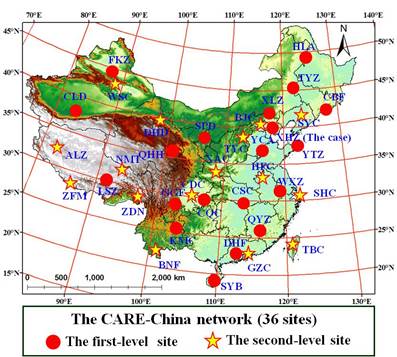
Air pollution and aerosol components are serious and complex in China, which are aggravating the uncertainties of regional and global climate change. It is essential to investigate the distribution of aerosol components over China. Based on a network of field stations supported by the Chinese Academy of Sciences (CAS), “Campaign on Atmospheric Aerosol Research” network of China (CARE-China) was recently established as the country’s first monitoring network for the study of the spatiotemporal distribution of aerosol physical characteristics, chemical components and optical properties, as well as aerosol gaseous precursors.

Figure 1. Geographic distribution of the CARE-China network. (Xin et al, 2015)
The network comprises 36 stations in total and adopts a unified approach in terms of instrumentation, experimental standards and data specifications. This ongoing project is intended to provide an integrated research platform to monitor online PM2.5 concentrations, nine-size aerosol concentrations and chemical component distributions, nine-size secondary organic aerosol (SOA) component distributions, gaseous precursor concentrations (including SO2, NOx, CO, O3 and VOCs), and aerosol optical properties. These data will be used to identify the sources of regional aerosols, the relative contributions from nature and anthropogenic emissions, the formation of secondary aerosols, and the effects of aerosol component distributions on aerosol optical properties.
The results will reduce the levels of uncertainty involved in quantitative assessment of aerosol effects on regional climate and environmental changes, and ultimately provide insight into mitigating China's anthropogenic aerosol emissions. The present paper provides a detailed description of the instrumentation, methodologies and experimental procedures used across the network, as well as a case study of observations taken from one station and the distribution of main components of aerosol over China during 2012.
Sulfate ion, OC and EC are the main components of aerosol. They differ greatly in the spatial and temporal distribution over China. The concentrations of SO42-, OC and EC were dramatically higher in North China, the central and eastern region and the cities than in the western, the background sites, especially in the Qinghai-Tibet plateau. SO42-, OC and EC of aerosol have two similar peaks in the fine mode and coarse mode almost all of sites. The phenomenon is largely different from the usual cognition that SO42-, OC and EC are mainly accumulated in fine mode of aerosol. So many aerosol models and climate models must be calibrated or adjusted by the real aerosol parameters in China, which is the only way to decline their errors and uncertainties in evaluating aerosol effects on the regional and global climate change.
Citation: Jinyuan Xin, Yuesi Wang, Yuepeng Pan, Dongsheng Ji, Zirui Liu, Tianxue Wen, Yinghong Wang, Xingru Li, Yang Sun, Jie Sun, Pucai Wang, Gehui Wang, Xinming Wang, Zhiyuan Cong, Tao Song, Bo Hu, Lili Wang, Guiqian Tang, Wenkang Gao, Yuhong Guo, Hongyan Miao, Shili Tian, and Lu Wang, 2015: The Campaign on Atmospheric Aerosol Research Network of China: CARE-China. Bull. Amer. Meteor. Soc., 96, 1137–1155. doi: http://dx.doi.org/10.1175/BAMS-D-14-00039.1.

86-10-68597521 (day)
86-10-68597289 (night)

86-10-68511095 (day)
86-10-68512458 (night)

cas_en@cas.cn

52 Sanlihe Rd., Xicheng District,
Beijing, China (100864)

